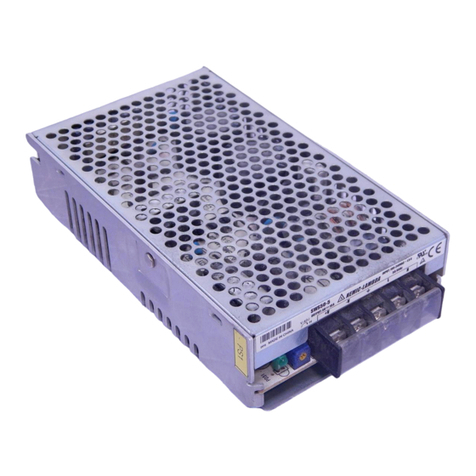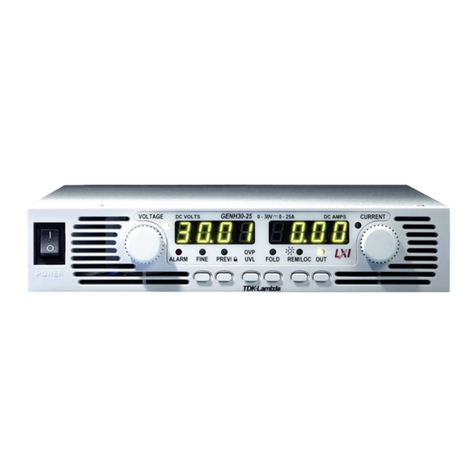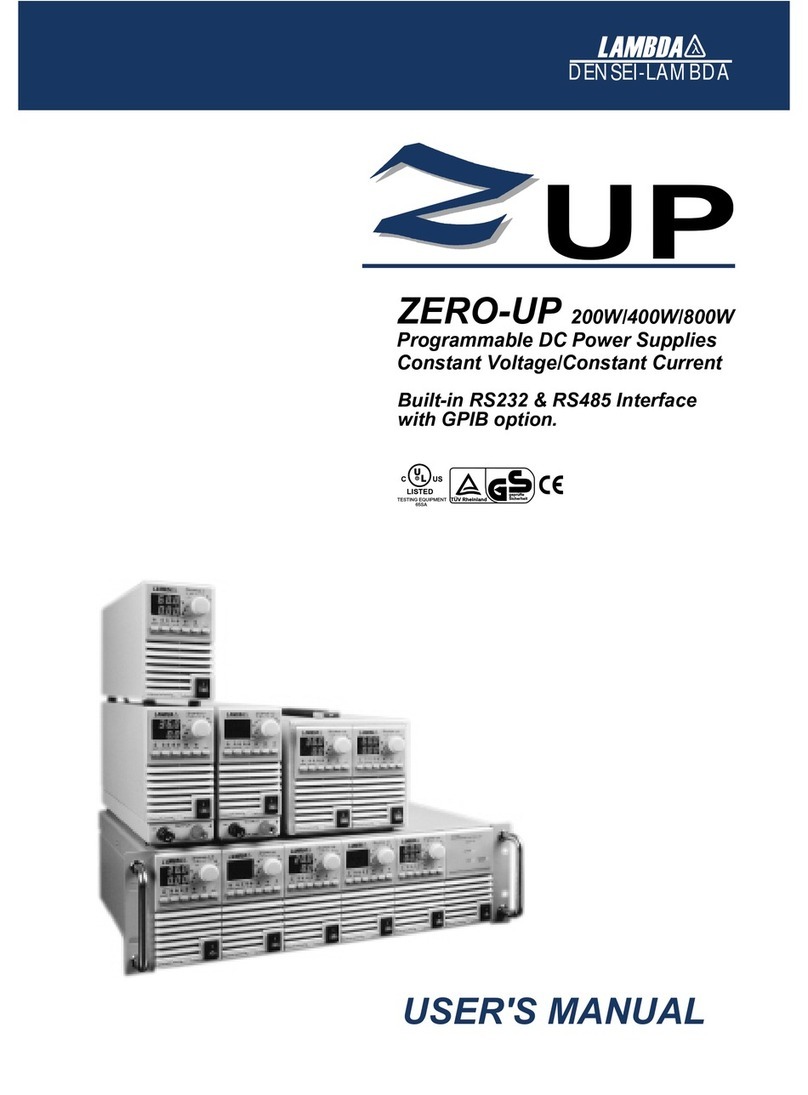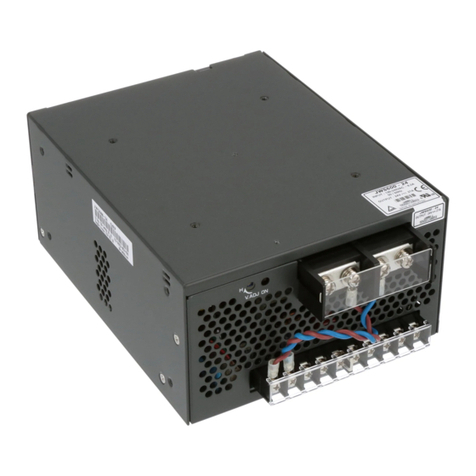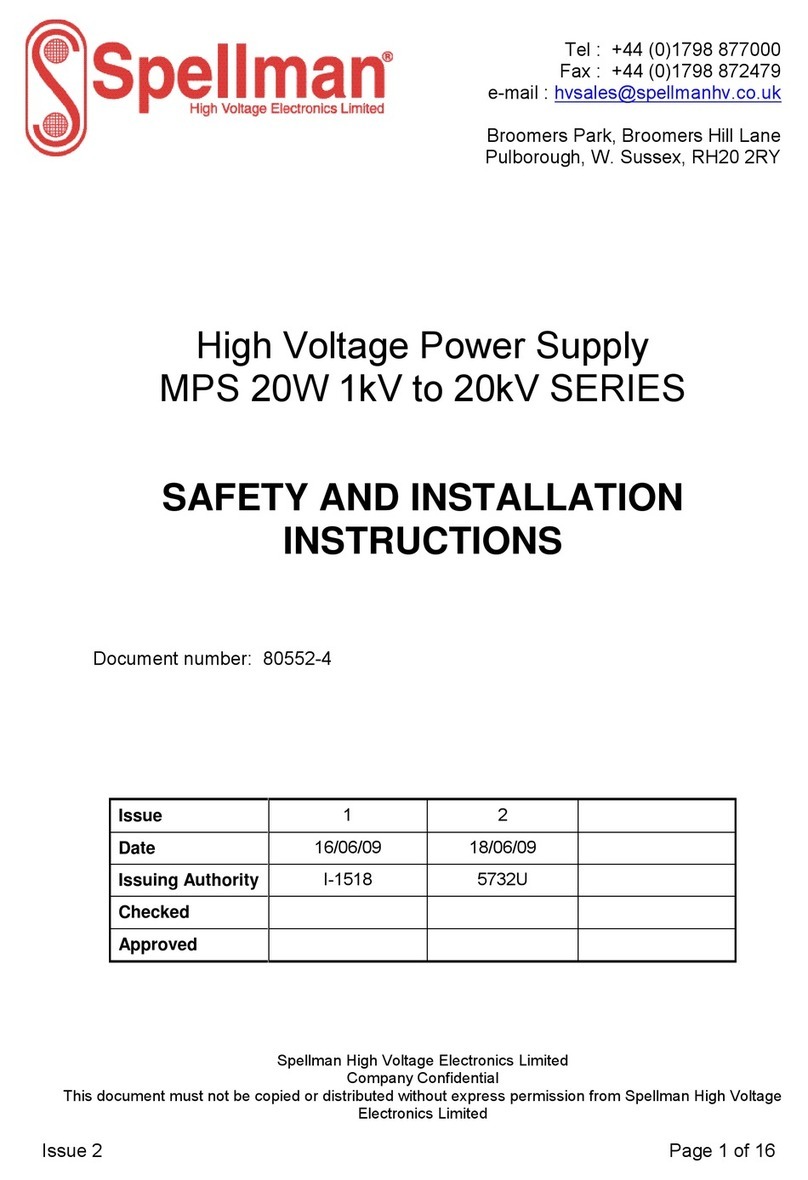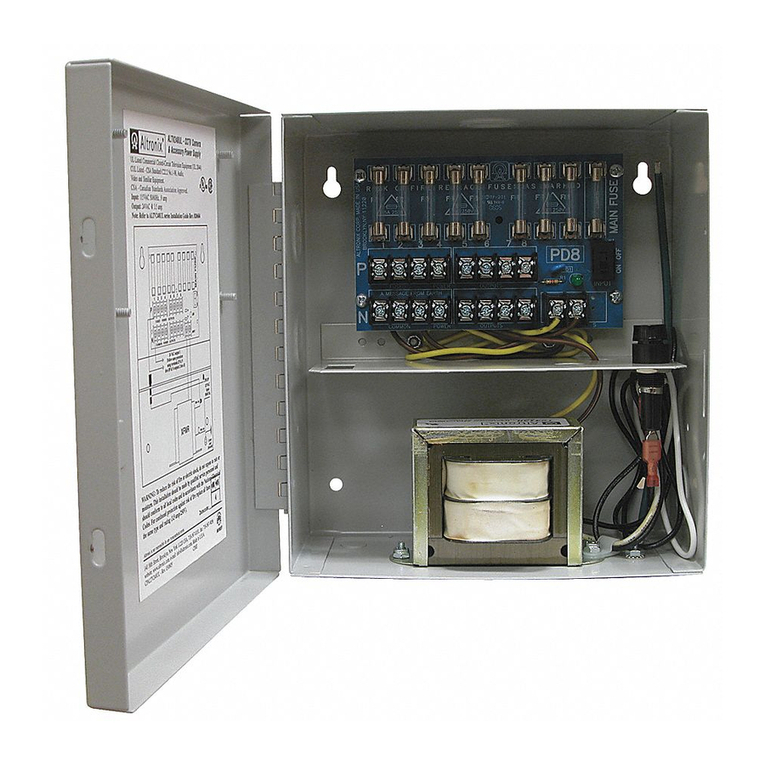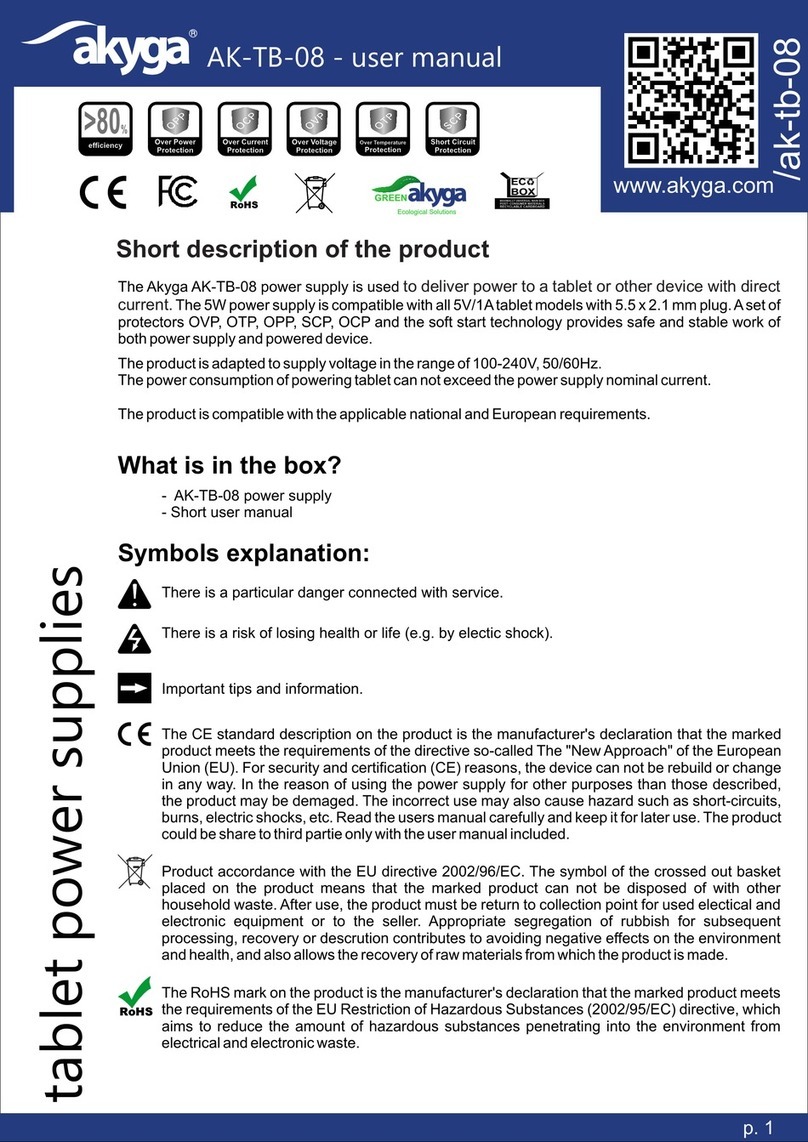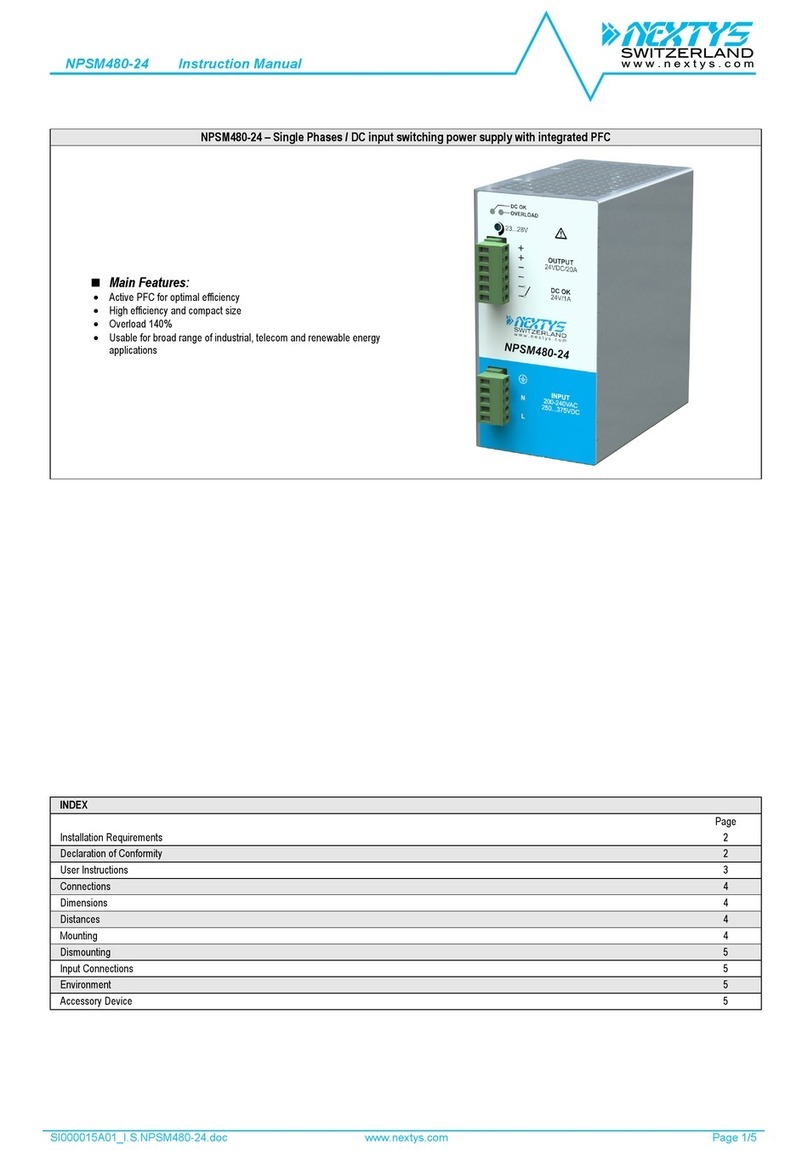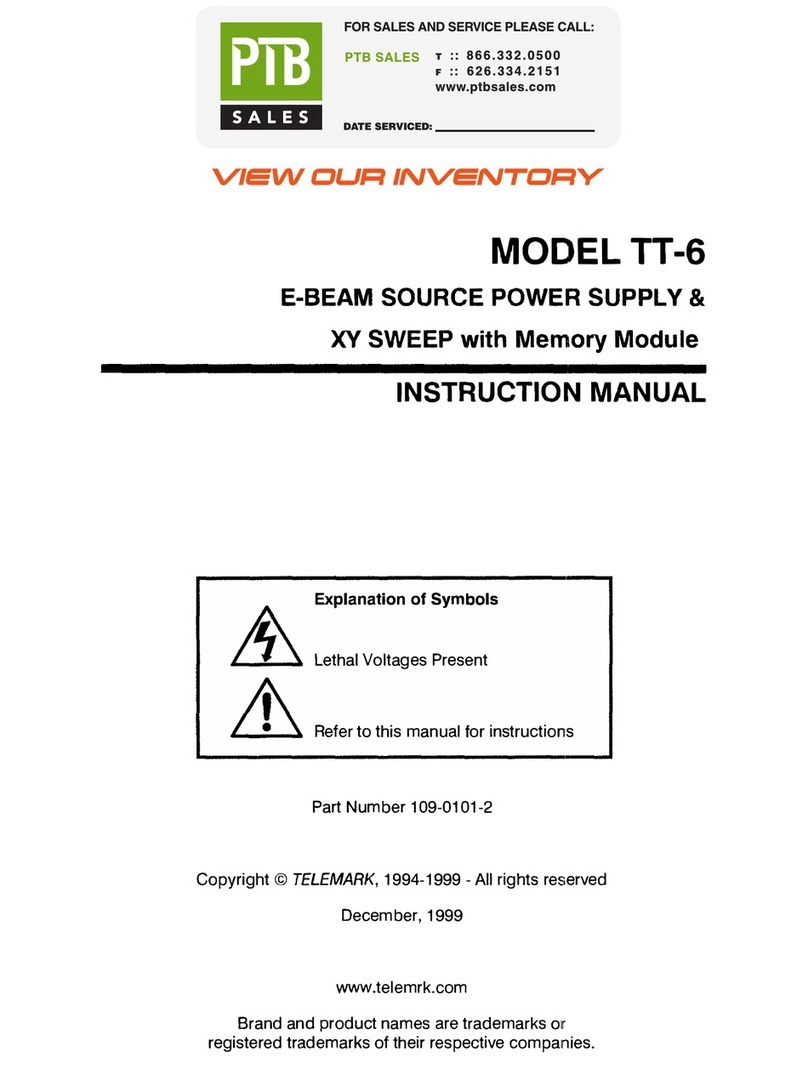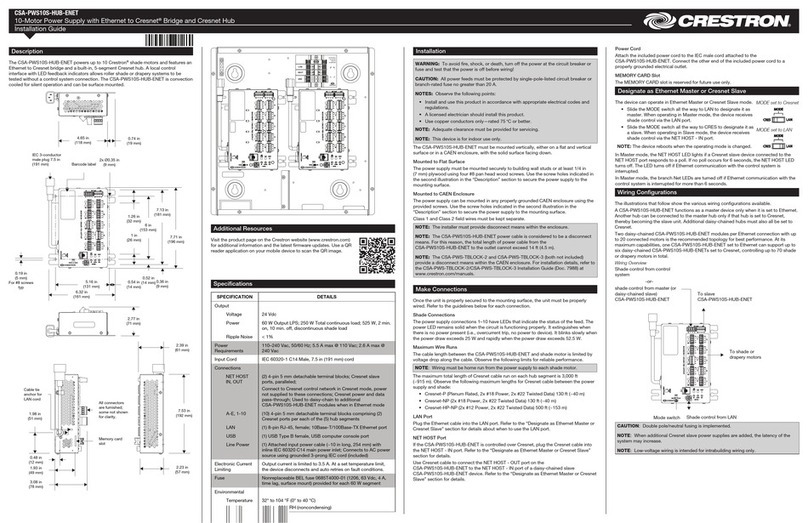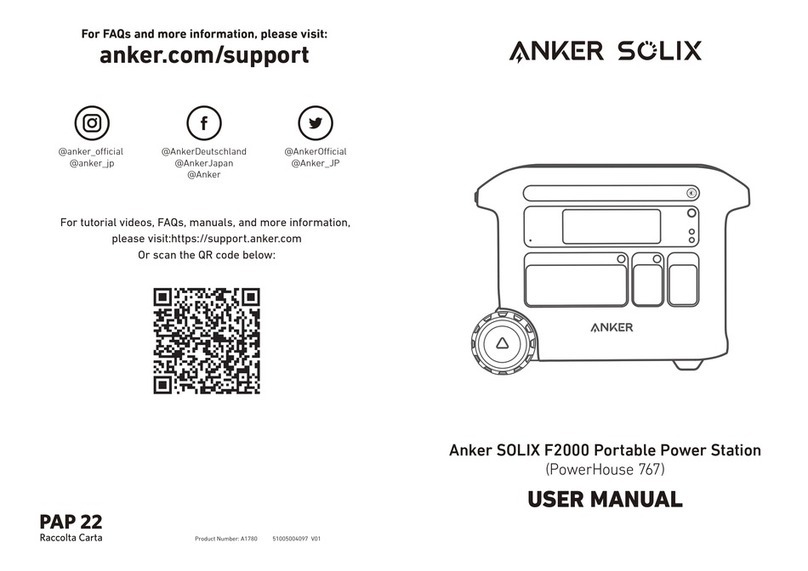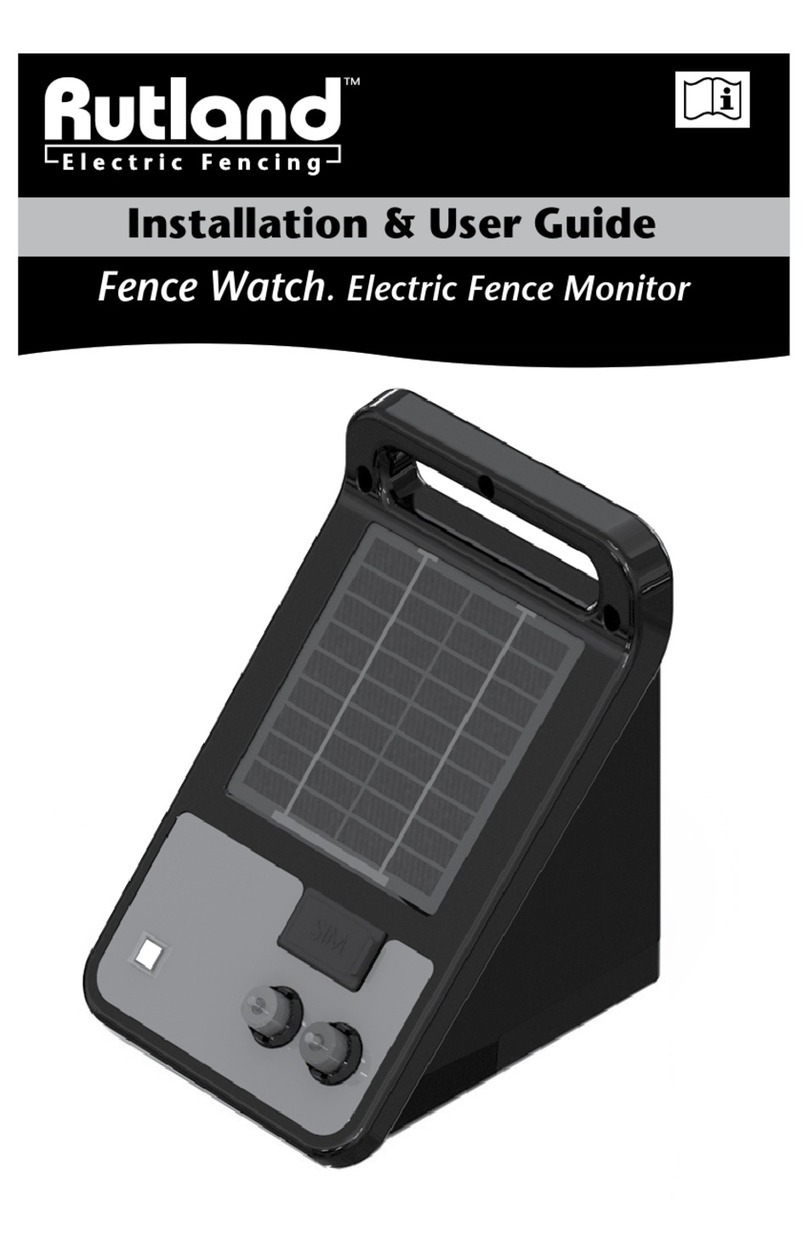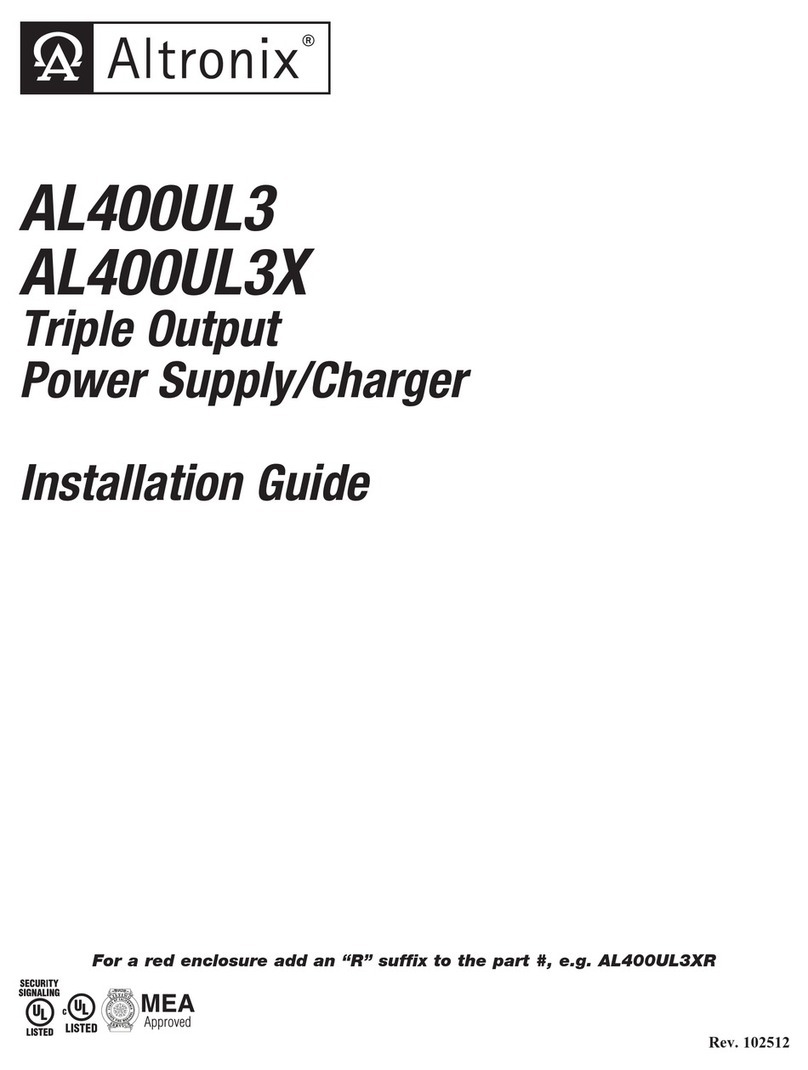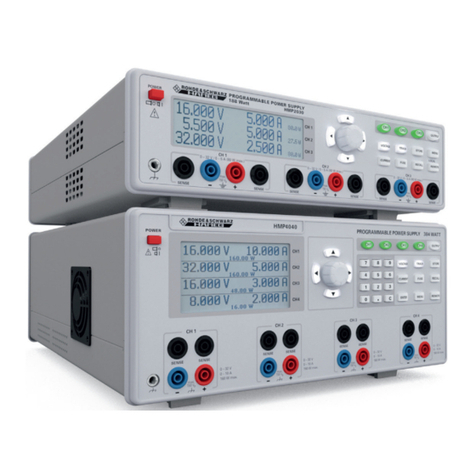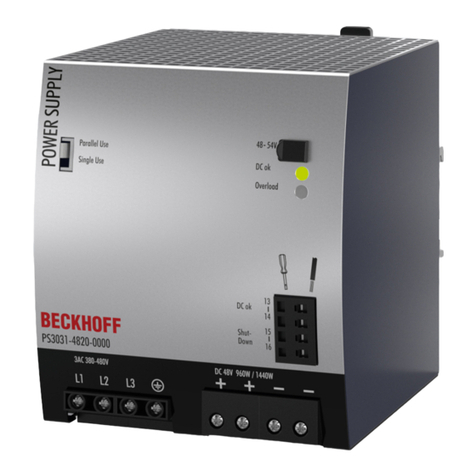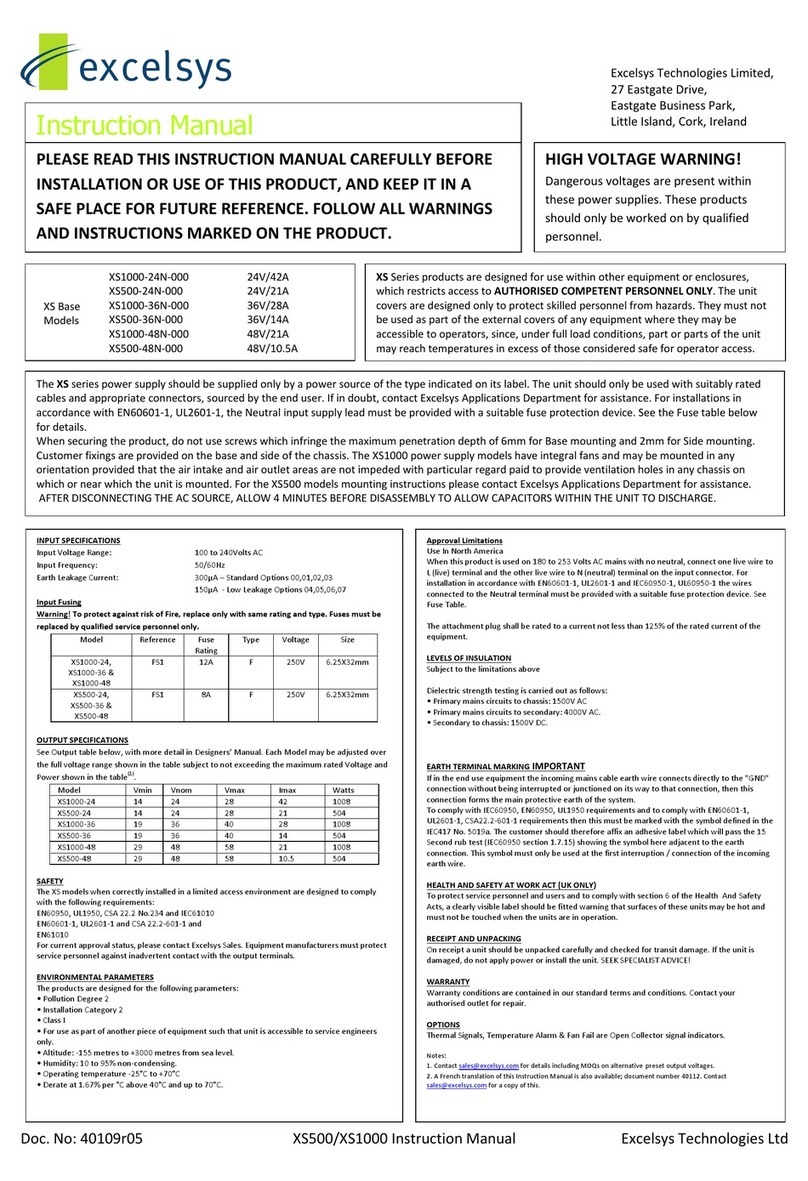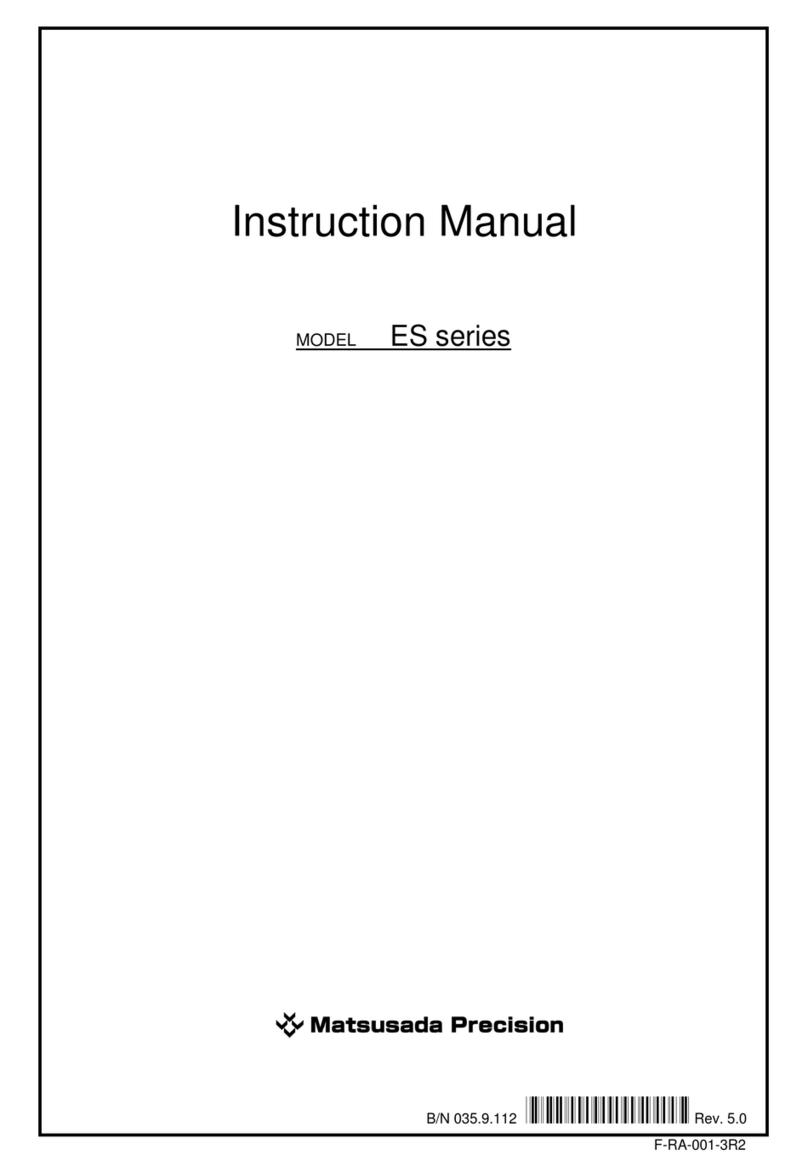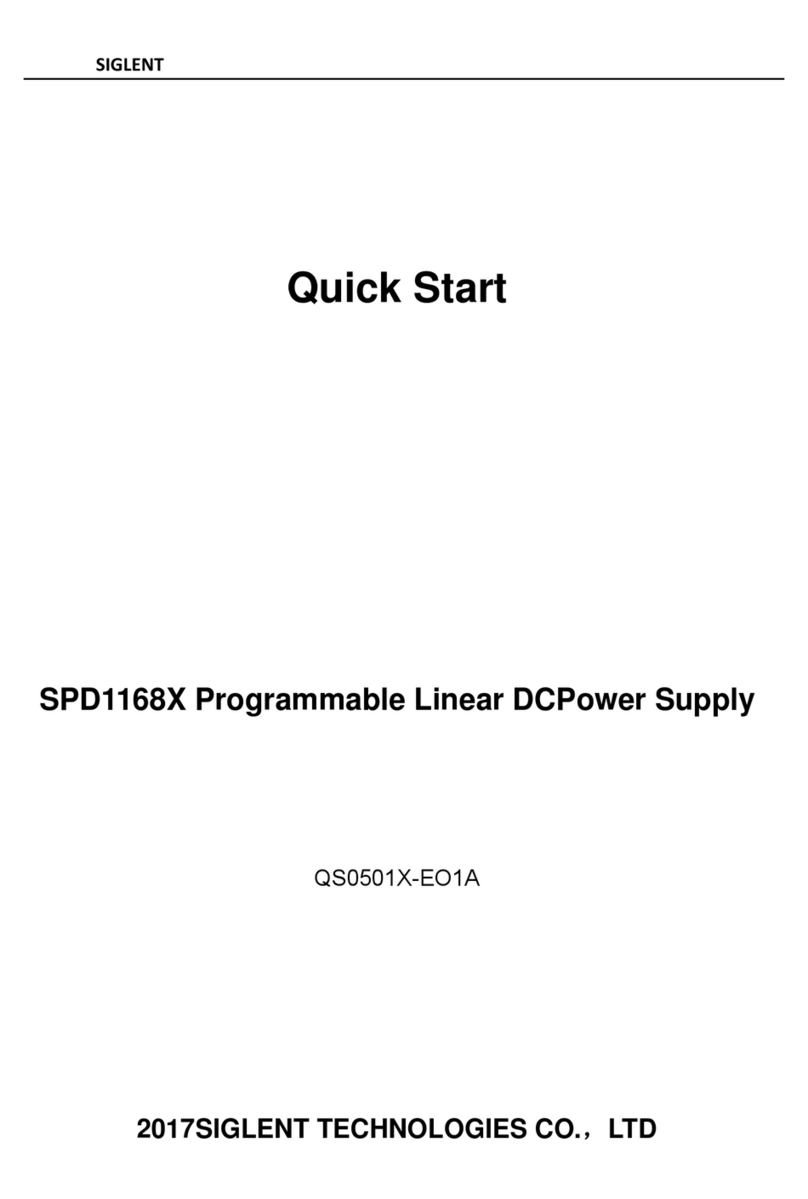Nemic-Lambda ZUP Series User manual

We Nemic-Lambda Ltd., located at Karmiel Industrial Zone, Israel, declare under our sole
responsibility that the product:
Product name: Programmable Regulated Power Supplies, ZUP Series
Models:
conforms to the following product specifications:
Safety: EN61010-1:2001
Electromagnetic Emissions:EN61326:1997:A3:2003 which covers testing to the following standards:
EN55011:1998:A2:2002 Conducted Emissions: Class B
Radiated Emissions: ClassA
IEC61000-4-2:1995 4.0KV CD, 4.0KV AD Level 2
IEC61000-4-3:1995 3V/m Level 2
IEC61000-4-4:1995 1.0KVAC Power Lines Level 2
0.5KV Communication Lines
IEC61000-4-5:1995 2.0KVAC Power Lines Level 3
1.0KVAC to Ground
1.0KV Communication Lines
IEC61000-4-6:1996 3V Level 2
IEC61000-4-11:1994
IEC61000-3-2:2000 ClassA
IEC61000-3-3:1995:A1:2001
The product herewith complies with the requirements of the Low Voltage Directive 73/23/EEC, as
amended by 93/68/EEC, and the EMC directive 89/336/EEC, as amended by 92/31/EEC and
93/68/EEC for Electrical Equipment used in Information Technology environments, and carries the CE
mark accordingly.
Our authorized representative in the EU is Coutant Lambda Limited, located at Kingsley Avenue,
Ilfracombe, Devon EX34 8ES, UK. Further, all products covered by this declaration are manufactured
by processes which ensure continued compliance of the products with the requirements of the Low
voltage and the EMC directives.
Name ofAuthorized Signatory:
Signature ofAuthorized Signatory:
Position ofAuthorized Signatory:
Date:
Place where signed:
Martin Southam
Director of Marketing, Coutant Lambda
June 1, 2006
Ilfracombe, UK
ZUP6-33
ZUP10-20
ZUP20-10
ZUP36-6
ZUP60-3.5
ZUP80-2.5
ZUP120-1.8
ZUP6-66
ZUP10-40
ZUP20-20
ZUP36-12
ZUP60-7
ZUP80-5
ZUP120-3.6
ZUP6-132
ZUP10-80
ZUP20-40
ZUP36-24
ZUP60-14
KARMIEL INDUSTRIAL ZONE, POB 500, ZC-20101, ISRAEL.
TEL: 972-4-9887491 FAX: 972-4-9887487
DECLARATION OF CONFORMITY


TABLE OF CONTENTS: ZUP SERIES
SAFETY INSTRUCTIONS .....................................................................
WARRANTY ..........................................................................................
CHAPTER 1. General Information
CHAPTER 2. Specifications
CHAPTER 3. Installation
......................................................
1.1 User manual content
1.2 Introduction
1.2.1 General description
1.2.2 Configurations
1.2.3 Control via the serial communication port
1.2.4 Output connections
1.2.5 Analog voltage programming
1.2.6 Parallel operation
1.2.7 Cooling and mechanical construction .....................................
1.3 Accessories
1.3.1 General
1.3.2 Serial link cables
1.3.3 AC cables
1.3.4 Front panel outputs option
................................................................
2.1 200W/400W Series
800W Series...................................................................................
2.2 Supplemental characteristics .........................................................
.....................................................................
3.1 General
3.2 Initial inspection
3.2.1 Mechanical inspection
3.2.2 Preparation for use
3.3 AC source requirements
3.4 Cooling and placement
3.5 Rack mounting
3.6 Power connection
3.7 Connecting the load .......................................................................
3.7.1 Selecting wire size
3.7.2 Wire termination .....................................................................
3.7.3 Single load connection, local sense
3.7.4 Single load connection, remote sensing ................................
3.7.5 Multiple load connections, radial distribution method
3.7.6 Multiple load connections with distribution terminals .............
3.7.7 Grounding outputs
3.8 External control connector
3.8.1 General
3.8.2 Pin description .......................................................................
3.8.3 Technical description
3.8.4 Default connections................................................................
3.9 Repackaging for shipment
pg. 2
pg. 1
pg. 5
pg. 6
pg. 7
pg. 9
pg. 11
pg. 12
pg.13
pg.14
pg.15
pg.16
pg.17
pg.18

Table 4-1: Front panel controls and indicators .......................................
4.2.2 Rear panel ............................................................................
4.2.3 Rear panel connections description .....................................
4.3 Turn-on Checkout Procedure
4.3.1 General
4.3.2 Prior to operation
4.3.3 Constant Voltage check
4.3.4 Constant Current check ........................................................
4.3.5 OVP check
4.3.6 UVP check
4.3.7 Foldback check
4.3.8 Output On/Off
4.3.9 Address setting
4.3.10 Local/Remote Operation
4.4 Local Operation ...............................................................................
4.4.1 Introduction
4.4.2 Constant Voltage Operation
4.4.3 Constant Current Operation
4.4.4 Automatic Crossover ..............................................................
4.4.5 Over Voltage protection (OVP)
4.4.6 Under Voltage Protection (UVP)
4.4.7 Foldback Protection ................................................................
4.4.8 Output On/Off Control
4.4.9 Last Setting memory ...............................................................
4.4.10 Output Voltage & Current programming by external resistor
4.4.11 Output Voltage Programming by external voltage .................
4.4.12 Output Current programming by external voltage
4.4.13 Auto Parallel operation...........................................................
4.4.14 Series Operation ....................................................................
4.4.15 Output good signal.................................................................
.....................................
5.1 Introduction
5.2 Configuration
5.2.1 Address setting
5.2.2 RS232 or RS485 selection
5.2.3 Baud rate setting
5.2.4 Local/remote selection
CHAPTER 5. RS232 & RS485 remote control
.................................................
4.1 Introduction
4.2 Controls and Indicators
4.2.1 Front Panel
CHAPTER 4. Operating Instructions.
pg.23
pg.22
pg.24
pg.25
pg.26
pg.27
pg.28
pg.29
pg.30
pg.32
pg.33
pg.37
pg.38
pg.35
TABLE OF CONTENTS: ZUP SERIES
3.10 Outline drawings: ZUP 200W & 400W series.................................
3.11 Outline drawing: ZUP 800W series...............................................
3.12 Outline drawing: front panel connector option ...............................
pg.19
pg.20
pg.21

5.4.1 Introduction
5.4.2 RS485 cable
5.4.3 Linking power supplies
5.5 ZUP series command set description
5.5.1 ID control commands...............................................................
5.5.2 Initialization control
5.5.3 Output control..........................................................................
5.5.4 Status control ..........................................................................
5.5.4.1 Registers structure
5.5.4.2 Status control commands ....................................................
5.6 Communication Protocol..................................................................
5.6.1 General information
5.6.2 Accessing a ZUP unit
5.6.3 End of message
5.6.4 Communication Test set up.................................................... pg.48
5.7.Service Request................................................................................. pg.49
................................................................... pg.50
6.1 Introduction
6.2 Units under warranty
6.3 Periodic Maintenance
6.4 Adjustment and calibration
6.5 Part replacement and repairs
6.6 Fuse ratings
...................................................................... pg.51
CHAPTER 6. Maintenance
USER’S MANUAL INDEX
pg.45
pg.42
pg.46
pg.43
pg.47
5.7.1 Service Request (SRQ)
5.7.2 Service Request message
5.7.3 Service Request enable/disable commands
TABLE OF CONTENTS: ZUP SERIES
5.3 Remote programming via RS232.....................................................
5.3.1 Introduction
5.3.2 Rear panel connectors pinout
5.3.3 RS232 cable ............................................................................
5.3.4 Linking power supplies
5.4 Remote programming via RS485 .....................................................
pg.39
pg.40
pg.41

WARRANTY SERVICE
WARRANTY
DISCLAIMER
LIMITATION OF WARRANTY
TRADEMARK INFORMATION
This product must be returned to an authorized Nemic-Lambda service facility for repairs or other
warranty service. For products returned to Nemic-Lambda for warranty service, the buyer shall prepay
shipping charges to Nemic-Lambda and Nemic-Lambda shall pay the shipping charges to return the
product to the buyer.
This Nemic-Lambda product is warranted against defects in materials and workmanship for a period of
three years from date of shipment .During the warranty period, Nemic-Lambda will, at it’s option, either
repair or replace products which prove to be defective.
The information contained in this document is subject to change without notice. Nemic-Lambda shall
not be liable for errors contained in this document or for incidental or consequential damages in
connection with the furnishing, performance or use of this material. No part of this document may be
photocopied, reproduced or translated into another language without the prior written consent of
Nemic-Lambda.
The warranty shall not apply to defects resulting from improper or inadequate usage or maintenance by
the buyer , buyer supplied products or interfacing. The warranty shall not apply to defects resulting
from unauthorized modifications or from operation exceeding the environmental specifications of the
product.
Nemic-Lambda does not warrant the buyers circuitry or malfunctions of Nemic-Lambda products
resulting from the buyer’s circuitry. Furthermore, Nemic-Lambda does not warrant any damage
occurring as a result of the buyer’s circuitry or the buyer’s - supplied products.
No other warranty is expressed or implied.
Microsoft and Windows are trademarks of Microsoft Corporation.

SAFETY INSTRUCTIONS
CAUTION
INSTALLATION CATEGORY
GROUNDING
FUSES
LIVE CIRCUITS
PART SUBSTITUTIONS & MODIFICATIONS
ENVIRONMENTAL CONDITIONS
INPUT RATINGS
The following safety precaution must be observed during all phases of operation, service and repair of
this equipment. Failure to comply with the safety precautions or warnings in this document violates
safety standards of design, manufacture and intended use of this equipment and may impair the built-in
protections within.
Nemic-Lambda shall not be liable for user’s failure to comply with these requirements.
The ZUP Series has been evaluated to INSTALLATION CATEGORY II. Installation Category (over
voltage category) II: local level, appliances, portable equipment etc.. With smaller transient over
voltages than Installation Category (over voltage category) III.
This product is a Safety Class 1 instrument. To minimize shock hazard, the instrument chassis must be
connected to an electrical ground. The instrument must be connected to the AC power supply mains
through a three conductor power cable, with the ground wire firmly connected to an electrical ground
(safety ground) at the power outlet.
For instruments designed to be hard - wired to the supply mains, the protective earth terminal must be
connected to the safety electrical ground before an other connection is made. Any interruption of the
protective ground conductor, or disconnection of the protective earth terminal will cause a potential
shock hazard that might cause personal injury.
Fuse must be changed by authorized Nemic-Lambda service personnel only. For continued protection
against risk of fire, replace only with the same type and rating of fuse. Refer to maintenance instructions
in chapter 6 for fuse rating.
Operating personnel must not remove the instrument cover. No internal adjustment or component
replacement is allowed by non-Nemic-Lambda qualified service personnel. Never replace
components with power cable connected. To avoid injuries, always disconnect power, discharge
circuits and remove external voltage sources before touching components.
Part substitutions and modifications are allowed by authorized Nemic-Lambda service personnel only.
For repairs or modifications, the instrument must be returned to a Nemic-Lambda service facility.
The ZUP series safety approval applies to the following operating conditions:
* Indoor use * Ambient temperature: 0 C to 50 C
* Maximum relative humidity: 90% (no dew drop) * Altitude: up to 3,000 m
* Pollution degree 2
O O
Do not use AC supply which exceeds the input voltage and frequency rating of this instrument. The
input voltage and frequency rating of the ZUP Series is; 100-240V~, 50/60Hz. For safety reasons, the
mains supply voltage fluctuations should not exceed +/- 10% of nominal voltage.

SAFETY INSTRUCTIONS
SAFETY SYMBOLS
Instruction manual symbol. The instrument will be marked with this symbol when it is
necessary for the user to refer to the instruction manual.
Indicates hazardous voltage.
Indicates ground terminal.
The WARNING sign denotes a hazard.An attention to a procedure is called.
Not following procedure correctly could result in personal injury.
AWARNING sign should not be skipped and all indicated conditions must be
fully understood and met.
The CAUTION sign denotes a hazard. An attention to a procedure is called.
Not following procedure correctly could result in damage to the equipment.
Do not proceed beyond a CAUTION sign until all indicated conditions are
fully understood and met.
FCC COMPLIANCE NOTICE:
Note: This equipment has been tested and found to comply with the limits for a Class A digital
device, pursuant to part 15 of the FCC Rules. These limits are designed to provide reasonable
protection against harmful interference when the equipment is operated in a commercial
environment. This equipment generates uses, and can radiate radio frequency energy and, if
not installed and used in accordance with the instruction manual, may cause harmful
interference to radio communications. Operation of this equipment in a residential area is
likely to cause harmful interference in which case the user will be required to correct the
interference at his own expense.
!
WARNING
CAUTION

OUTPUT TERMINALS COVER
Models up to 60V output voltage
After connection of the load wires ( refer to par. 3-7 ), attach the plastic cover to the rear panel of the
power supply, using two self tapping screws supplied with the unit. Refer to Fig. 1-1 for details.
Fig. 1-2: Output wires connection
OUTPUT CONNECTOR COVER
80V and 120V models
MALE CONNECTOR (PSC1.5/3-M-PE , Phoenix)
FEMALE PLUG (PSC 1.5/3-F)
PLASTIC PLUG COVER
Wires : Copper , AWG16-30
Tightening torque : 4lib-in
WARNING
Hazardous voltages may exist at the output terminals.
Attach the terminals cover, supplied with the unit, to the chassis after connecting the load wires as
described below.
Fig. 1-1: Terminals cover assembly
REAR PANEL
LOAD WIRES
PLASTIC COVER
SAFETY INSTRUCTIONS
+V -V

CHAPTER 1 GENERAL INFORMATION
1.1 USER’S MANUAL CONTENT
1.2 INTRODUCTION
1.2.1 General description
1.2.2 Configurations
1.2.4 Output connections
1.2.5 Analog voltage programming
1.2.6 Parallel operation
1.2.3 Control via the serial communication port
This user’s manual contains the operating instructions, installation instructions and specifications of
the ZUP series. For information related to operation with GPIB control, refer to Nemic-Lambda GP485
user’s manual.
The ZUP series are wide range output switching power supplies with laboratory performance. The ZUP
series is power factor corrected and operates from worldwide AC voltage range continuously. Output
voltage and current are continuously displayed and LED indicators show the complete operating status
of the power supply. The front panel controls allow the user to set the output parameters, the protection
levels (over-voltage / under-voltage)and arm the foldback protection to disable the output if the unit
switches from Constant-voltage mode to Constant-current mode.
The ZUP can be configured into a programmable power system of up to 31 DC outputs using the built-in
RS232 or RS485 communication port in the power supply. In a GPIB system the GP485 controller can
control up to 31 ZUP units in a single GPIB address.
Output connections are made to rear panel bus-bars for models up to 60V and connector for the 80V
and 120V models. Either the positive or negative terminal may be grounded or the output may be
floated. The maximum potential (including the output voltage) that either output terminal is from ground
must not exceed the rated output voltage. Local or remote sense may be used. In remote sense, the
maximum voltage drop on each wire is 0.5V for models up to 60V and 2V for the 80V and 120V models.
Analog inputs are provided at the rear panel for analog voltage programming of output voltage and
current, and On/Off control. Inputs are provided for resistive programming of the output voltage and
current.
Zup units of the same output voltage and current rating can be paralleled in master-slave configuration
with automatic current sharing for power-up purposes.
The following parameters can be programmed via the serial communication port:
1. Output voltage setting
2. Output current setting
3. Output On/Off
4.Arming or release of the foldback protection
5. Over-voltage protection setting
6. ‘Soft’ under-voltage limit
7. Output voltage measurement
8. Output current measurement
9. Power supply start-up mode
(last setting or safe mode)
10. Over-voltage protection setting read
11. Under-voltage limit read
12. Remote/Local Control

1.3.1 General
1.3.4 Front Panel Outputs option
1.3.3 AC Cables
1.3.2 Serial link cables
1.3 ACCESSORIES
Accessories are delivered with the power supply or separately upon ordering.
Below are listed possible accessories and ordering numbers.
PART No. DESCRIPTION
NL 100 19” rack, 3U height
NL 200 Dual output packing
NL 101 Blank panel for 19” rack
NL 102 Additional instruction manual
PART No. MARKET DESCRIPTION
ZUP/U USA 13A, 125V, unshielded, 2m typ. length, with IEC320 connector on one
(NC301) side and NEMA-5-15P connector the on other side.
ZUP/E Europe 10A, 250V, unshielded, 2m typ. length, with IEC320 connector on one
(NC302) side and INT’L 7 standard VII, dual earthing on the other side.
ZUP/O General 10A, 250V, unshielded, 2m typ. length, with IEC320 connector on one
(NC303) side and unterminated stripped wires on the other side. Use the cable
only with plug approved by the national safety standards of the country
of usage.
ZUP/J Japan 13A, 125V unshielded, 2m typ. length, with IEC320 connector on one
(NC305) side and Japan type plug on other side.
In cases where load connection at the front panel is required, optional Front Panel output Jacks for a
load current of 20A maximum is available. Please note that the power supply height is increased with
this option. Refer to outline drawing (par. 3.12) for details.
ORDER No. DESCRIPTION
ZUP /L 20AFront Panel Output Jacks
Serial link cable, for linking power supplies by RS485 communication is provided with the power supply
according to order. Cable description: 0.5m typ. length, shielded, EIA-568Atype plugs, 8 contacts.
Refer to par.5.3.4 , for details.
1.2.7 Cooling and mechanical construction
The Zup series is fan cooled. Upon installation take care to allow free air flow into the power supply via
the front panel and out of the power supply via the rear panel. The ZUP series is contained in a compact,
lightweight package which allows for easy installation and space saving in the application equipment.

CHAPTER 2 SPECIFICATIONS
2.1 SPECIFICATIONS: 200W/400W Series
ZUP20-
20
ZUP20-
10
ZUP10-
40
ZUP10-
20
ZUP6-
66
ZUP6-
33
ZUP60-
7
0~7
0~12
ZUP60-
3.5
0~3.5
0~6
216 432 210 420
ZUP36-
12
ZUP36-
6
0~360~60
ZUP120-
3.6
ZUP120-
1.8
ZUP80-
5
ZUP80-
2.5
V
A
W
-
-
mV
mV
mS
-
-
mS
mS
mS
-
-
mA
-
-
-
-
-
-
V
-
-
-
-
-
-
A
-
-
%
A
MODEL
OUTPUT VOLTAGE (*1)
OUTPUT CURRENT (*2)
RATED OUTPUT POWER
LOAD REGULATION
LINE REGULATION
RMS RIPPLE
RIPPLE
RECOVERYTIME (*4)
TEMPERATURE COEFFICIENT
TEMPERATURE DRIFT
(5Hz-1MHz Bandwidth)
(pk to pk20MHz Bandwidth)
LOAD REGULATION
LINE REGULATION
RMS RIPPLE
TEMPERATURE COEFFICIENT
TEMPERATURE DRIFT
(5Hz-1MHz Bandwidth)
INPUT VOLTAGE (*8)
INPUT CURRENT (*6)
INPUT CURRENT HARMONICS
POWER FACTOR (TYP)
EFFICIENCY (*6)
INRUSH CURRENT (*7)
100/200V
VOLTAGE
CURRENT
STATUS
UP PROGRAMMING RESPONSE TIME
FULL LOAD
NO LOAD
RESOLUTION
ACCURACY
RESOLUTION
ACCURACY
VOLTAGE
CURRENT
CONSTANT
VOLTAGE
CONSTANT
CURRENT
DOWN
PROGRAMMING
RESPONSE TIME
PROGRA-
MING (*3)
DISPLAY
OVERVOLTAGE PROTECTION (*5)
HOLD UP TIME
OUTPUT PROTECTIONS
INPUT
10
5.6/2.7 5.3/2.6
80/8482/86
15
5.6/2.7 4.9/2.4
80/8483/87
0~20
30
5.6/2.7
79/83
0~40
50
5.6/2.7
79/82
0~66
0.005% +2mV (*10) 0.005% +4mV
0.005% +1mV (*11) 0.005% +2mV
5
50
30ppm/ Cfrom rated voltage following 30-minute warm-up
O
0.01% +2mV change in output over 8-hour interval under constant line, load and ambient
temperature following 30-minute warm-up
50
50
100
5.6/2.7
74/77
15 15 15 15 15
15 15
5555
5
2.9/1.4 2.9/1.4
75/7978/82
7.5
2.9/1.4 2.6/1.3
76/8078/82
0~10
15
2.9/1.4
74/78
0~20
25
2.9/1.4
73/77
0~33
198 396 200 400 200 400
50
3.0/1.5
69/72
15/3015/3015/3015/3015/30
15/3015/30
250
0-7.5
1
350
0 -13
0.5
400
0-24
0.2
0.01% + 5mA for load voltage change equal to unit voltage rating , constant input voltage.
0.01% +2mA from 85-132VAC or 170-265VAC, constant load
20mS at 100V/200VAC, rated output voltage and output current
100ppm/ Cfrom rated current following 30 minute warm-up
O
Better than 0.028% of rated output voltage
0.02% + 5mV 0.02% + 8mV 0.02% +12mV0.02% +26mV 0.02% +35mV
0.4% +40mA
Better than 0.03% of rated output current
0.02% +5mA change in output over 8-hour interval under constant line, load and ambient
temperature following 30 minute warm-up
3 digits (6V,20V,36V,60V,80V) 3.5 digits (10V,120V) accuracy: 0.2% +/-2digits
3 digitsaccuracy: 0.5% +/-3digits
CV/CC, Alarm, Fold, Local/Remote, ON/OFF
Over Voltage, Over Temperature, Foldback
85 ~ 265VAC Continuous, 47 ~ 63Hz
Complies with EN61000-3-2, Class A
0.99 at 100/200VAC, 100% Load
500
0-40
0.02%+50mV
0.4%+ 0.4%+0.4%+ 0.4%+
15mA 30mA 10mA 20mA
0-880 - 132
0.02%+80mV
0.2
750
0-66
0.2
100
0~6 0~100~20
0~1.8
0~5
20
0~3.6
0~2.5
20
200
70
60
0.2
800
400
80
80
0.2
1000
216 432
0~800 ~ 120

-
-
-
-
-
-
Kg
mm
-
-
-
-
-
-
-
-
-
-
-
-
-
-
-
OPERATING TEMPERATURE
OPERATING HUMIDITY
STORAGE TEMPERATURE
STORAGE HUMIDITY
VIBRATION (*9)
SHOCK
WEIGHT
SIZE (WxHxD)
OUTPUT ON/OFF
OUTPUT GOOD
OUTPUT VOLTAGE PROGR.
OUTPUT CURRENT PROGR.
REMOTE SENSING
COMMUNICATION INTERFACE
ENVIRON-
MENT
MECHANI-
CAL
EXTERNAL
FUNCTIONS
SAFETY STANDARDS
EMC STANDARDS
APPRO-
VALS
NOTES:
*1MINIMUM VOLTAGE IS GUARANTEED TO MAXIMUM 0.2% OF THE RATED OUTPUT VOLTAGE.
*2MINIMUM CURRENT IS GUARANTEED TO MAXIMUM 0.4% OF THE RATED OUTPUT CURRENT.
*3GIVEN FOR CONTROL OF THE OUTPUT VIA THE SERIAL COMMUNICATION OR VIAFRONT PANEL CONTROLS.
* 4 TIME FOR RECOVERY TO WITHIN +/- 50mV AGAINST CURRENT CHANGE OF 50% TO 100%.
*5INVERTER SHUT DOWN METHOD, MANUAL RESET BY AC INPUT RECYCLING.(OVP WILL SHUT DOWN OUTPUT).
* 6 AT 100V/200V AND MAXIMUM OUTPUT POWER.
* 7 FOR 200W UNITS -AT COLD START Ta = 25°C.
* 8 FOR CASES WHERE CONFORMANCE TO VARIOUS SAFETY SPECS, (UL, IEC ETC.)ARE REQUIRED TO BE DESCRIBED
AS 100-240VAC (50/60Hz) ONNAME PLATE.
* 9 WHEN MOUNTED WITH MOUNTING SCREWS.
*10 FROM NO LOAD TO FULL LOAD , CONSTANT INPUT VOLTAGE AT REMOTE SENSE.
*11FROM 85~132VAC OR 170~265VAC , CONSTANT LOAD.
*12 FROM ZERO VOLTS TO FULL SCALE , RESISTIVE LOAD , CURRENT SETTING AT MAX.
CONDUCTED EMI
RADIATED EMI
SERIAL OPERATION
PARALLEL OPERATION
COOLING
ISOLATION RESISTANCE
WITHSTAND VOLTAGE
ZUP60-
7
3.2
3.2
3.2
ZUP60-
3.5
2.9
2.9
2.9
ZUP36-
12
ZUP36-
6
ZUP20-
20
ZUP20-
10
ZUP10-
40
ZUP10-
20
ZUP6-
66
0~50C: 100% Load.
O
-20~70C
O
30 ~ 90% RH(NoDewdrop )
10 ~ 95% RH(NoDewdrop )
Less than 20G
10 ~ 55Hz, Amplitude (sweep 1min) Less than 2G, X,Y
, Z, 1 hour each.
70 x 124 x 350.
By TTL Signal or Dry Contact - refer to instruction manual
Open collector-refer to instruction manual
By Voltage(0~4V)or byResistance(0~4K)refer to instruction manual
By Voltage(0~4V)or byResistance(0~4K)refer to instruction manual
Maximum possible drop oneach load wire is 0.5Vfor models up to60V and 2V for the 80V and 120V models.
RS232 and RS485 Built-in, IEEE488 Optional
UL 3111-1, EN61010-1
EN 61326-1, IEC 61326 -1, FCC part 15 (class A)
Master-slave method: up to 5 units, refer to instruction manual
Up to 2 units, refer to instruction manual
EN55022-B, FCC-B, VCCI-B
Forced air by blower fan, (blower fan ismounted within unit)
EN55022-A, FCC-A, VCCI-A
Input-Chassis: 2.0kVAC1min. Input-Output: 3.0kVAC1min. Output-Chassis: 500VAC 1min. Input-Chassis: 2.0kVAC1min..
Input-output(HAZ):2.0kVAC 1min.
Input-Output(SELV):3.0kVAC 1min.
ZUP6-
33
3.2
3.22.9
2.93.2
3.22.9
2.9
2.1 SPECIFICATIONS: 200W/400W Series continued
ZUP120-
3.6
ZUP120-
1.8
ZUP80-
5
ZUP80-
2.5
More than 100MOhm at 25 Cand 70% R.H.
O

V
A
W
-
-
mV
mV
mS
-
-
mS
mS
mS
-
-
mA
-
-
-
-
-
-
V
-
-
-
-
-
-
A
-
-
%
A
MODEL
OUTPUT VOLTAGE (*1)
OUTPUT CURRENT (*2)
RATED OUTPUT POWER
LOAD REGULATION
LINE REGULATION
RMS RIPPLE
RIPPLE
RECOVERYTIME (*4)
TEMPERATURE COEFFICIENT
TEMPERATURE DRIFT
(5Hz-1MHz Bandwidth)
(pk to pk20MHz Bandwidth)
LOAD REGULATION
LINE REGULATION
RMS RIPPLE
TEMPERATURE COEFFICIENT
TEMPERATURE DRIFT
(5Hz-1MHz Bandwidth)
INPUT VOLTAGE (*7)
INPUT CURRENT (*6)
INPUT CURRENT HARMONICS
POWER FACTOR (TYP)
EFFICIENCY (*6)
INRUSH CURRENT
100/200V
VOLTAGE
CURRENT
STATUS
UP PROGRAMMING RESPONSE TIME
FULL LOAD
NO LOAD
RESOLUTION
ACCURACY
RESOLUTION
ACCURACY
VOLTAGE
CURRENT
CONSTANT
VOLTAGE
CONSTANT
CURRENT
DOWN
PROGRAMMING
RESPONSE TIME
PROGRAM-
MING
(*3)
DISPLAY
OVERVOLTAGE PROTECTION (*5)
HOLD UP TIME
OUTPUT PROTECTIONS
INPUT
ZUP60-14
0~14
20
11.2/5.4
80/84
0~24
30
11.2/5.4
80/84
0~40
60
11.2/5.4
79/82
0~80
100
11.2/5.4
77/81
0 ~ 132
792 800 800 864 840
200
11.2/5.4
74/77
30
0.005% +2mV from no load to full load, constant input voltage
0.005% +1mV from 85-132VAC or 170-265VAC, constant load
5
80
30ppm/ °C from rated voltage following 30-minute warm-up
0.01% +2mV change in output over 8-hour interval under constant line, load and ambient
temperature following 30-minute warm-up
50
ZUP36-24
ZUP20-40
ZUP10-80
ZUP6-132
250
0-7.5
1
100
8
70
5
350
0-13
0.5
90
8
60
5
400
0-24
0.2
0.07% + 10mA for load voltage change equal to unit voltage rating , constant input voltage.
0.01% +5mA from 85-132VAC or 170-265VAC, constant load
20mS at 100V/200VAC, rated output voltage and output current
100ppm/ Cfrom rated current following 30 minute warm-up
O
0.05% +10mA change in output over 8-hour interval under constant line, load and ambient
temperature following 30 minute warm-up
3 digits (6V,20V,36V,60V) 3.5 digits (10V) accuracy: 0.2% +/-2digits
3.5 digits (132A), all others3digitsaccuracy: 0.5% +/-3digits
CV/CC, Alarm, Fold, Local/Remote, ON/OFF
Over Voltage, Over Temperature, Foldback
85 ~ 265VAC Continuous, 47 ~ 63Hz
Complies with EN61000-3-2, Class A
0.99 at 100/200VAC, 100% Load
500
0-40
0.2
750
70
0-66
0.2
0~6 0~100~200~360~60
2.1 SPECIFICATIONS: 800W Series
Better than 0.028% of rated output voltage
0.4% +40mA
Better than 0.03% of rated output current
50mS (From zero volts to full scale, resistive load, current setting atmax.)
0.02% +5mV 0.02% + 8mV 0.02% +12mV0.02% +26mV0.02% +35mV

-
-
-
-
-
-
Kg
mm
-
-
-
-
-
-
-
-
-
-
-
-
-
-
-
OPERATING TEMPERATURE
OPERATING HUMIDITY
STORAGE TEMPERATURE
STORAGE HUMIDITY
VIBRATION (*8)
SHOCK
WEIGHT
SIZE (WxHxD)
OUTPUT ON/OFF
OUTPUT GOOD
OUTPUT VOLTAGE PROGR.
OUTPUT CURRENT PROGR.
REMOTE SENSING
COMMUNICATION INTERFACE
ENVIRON-
MENT
MECHANI-
CAL
EXTERNAL
FUNCTIONS
APPLICABLE SAFETY STANDARDS
APPLICABLE EMC STANDARDS
CONDUCTED EMI
RADIATED EMI
SERIAL OPERATION
PARALLEL OPERATION
COOLING
WITHSTAND VOLTAGE
ISOLATION RESISTANCE
ZUP60-
14
5.8
ZUP36-
24
ZUP20-
40
ZUP10-
80
ZUP6-
132
0~50C: 100% Load.
O
-20~70C
O
30 ~ 90% RH(NoDewdrop )
10 ~ 95% RH(NoDewdrop )
Less than 20G
10 ~ 55Hz, Amplitude ( sweep 1min ) Less than 2G, X,Y
, Z,1hour each.
140 x 124 x 350 refer tooutline drawing
By TTL Signal or Dry Contact - refer to instruction manual
Open collector-refer to instruction manual
By Voltage(0~4V)or byResistance(0~4K)refer to instruction manual
By Voltage(0~4V)or byResistance(0~4K)refer to instruction manual
Possible, maximum 0.5V drop on each load wire
RS232 and RS485 Built-in, IEEE488 Optional
UL 3111-1, EN61010-1
EN 61326-1, IEC 61326 -1, FCC part 15 (class A)
Master-slave method: up to 5 units, refer to instruction manual
Up to 2 units, refer to instruction manual
More than 100MOhm at 25°C and 70% R.H.
EN55022-B, FCC-B, VCCI-B
Forced air by blower fan, (blower fan ismounted within unit)
EN55022-A, FCC-A, VCCI-A
Input - Chassis: 2.0kVAC1min. Input - Output: 3.0kVAC1min. Output - Chassis: 500VAC1min.
NOTES:
* 1 MINIMUM VOLTAGE IS GUARANTEED TO MAXIMUM 0.2% OF THE RATED OUTPUT VOLTAGE.
* 2 MINIMUM CURRENT IS GUARANTEED TO MAXIMUM 0.4% OF THE RATED OUTPUT CURRENT.
* 3 GIVEN FOR CONTROL OF THE OUTPUT VIA THE SERIAL COMMUNICATION OR VIA FRONT PANEL CONTROLS.
* 4 TIME FOR RECOVERY TO WITHIN +/- 50mV AGAINST CURRENT CHANGE OF 50% TO 100%.
* 5 INVERTER SHUT DOWN METHOD, MANUAL RESET BY AC INPUT RECYCLING.(OVP WILL SHUT DOWN OUTPUT).
* 6 AT 100V/200V AND MAXIMUM OUTPUT POWER.
* 7 FOR CASES WHERE CONFORMANCE TO VARIOUS SAFETY SPECS, (UL, IEC ETC.) ARE REQUIRED TO BE DESCRIBED
AS 100-240VAC (50/60Hz) ON NAME PLATE.
*8 WHEN MOUNTED WITH MOUNTING SCREWS.
2.1 SPECIFICATIONS: 800W Series continued

2.2 SUPPLEMENTAL CHARACTERISTICS
The supplemental characteristics give typical but non-warranted performance characteristics. The
supplemental characteristics are useful in accessing applications for the power supply. Several kinds
of supplemental characteristics are listed below.
1. EVALUATION DATA: Typical performance of the power supply.
2. RELIABILITY DATA: Reliability performance of the power supply.
3. IEC 1000 DATA: Performance of the power supply under IEC 1000 test conditions.
4. EMI DATA: Typical EMI (conducted and radiated) performance of the power supply.
The supplemental characteristics data are held in each Nemic-Lambda sales and service facility. For
further details please contact the Nemic-Lambda office nearest you.

CHAPTER 3 INSTALLATION
3.1 GENERAL
3.2 INITIAL INSPECTION
3.2.1 Mechanical inspection
3.2.2 Preparation for use
3.3 AC SOURCE REQUIREMENTS
3.4 COOLING & PLACEMENT
3.5 RACK MOUNTING
3.6 POWER CONNECTION
NOTE
CAUTION
This chapter contains instructions for initial inspection, preparation for use and repackaging for
shipment. Connection to PC, linking ZUP units and setting the address are described in chapter 5.
Prior to shipment this power supply was inspected and found free of mechanical or electrical defects.
Upon unpacking of the power supply, inspect for any damage which may have occurred in transit. Keep
all packing materials until inspection has been completed. If any damage is detected, file a claim with
the carrier immediately and notify the Nemic-Lambda sales or service facility nearest you.
The mechanical inspection should confirm that there is no exterior damage to the power supply such as
broken knobs or connectors and that the front panel and meter face are not scratched or cracked.
In order to be operational the power supply must be connected to an appropriate AC source. The line
voltage must be within the power supply specification. DO NOT apply power before reading paragraph
3.3.
The ZUP series can be operated from a nominal 100V to 240V, single phase, 47 ~ 63Hz. The input
voltage range and current required for each model is specified in chapter 2. Make sure that under
heavy load, theAC voltage supplied to the power supply does not fall below “low limit” specifications.
This power supply is fan cooled. Upon installation ensure sufficient space for air intake (front panel) and
exhaust (rear panel). The power supply should be used in an area where the ambient temperature
does not exceed +50 C
O
ZUP models can be mounted in a standard 19” rack (3U height). The 200W and 400W models occupy
1/6 rack length. The 800W model occupies 1/3 rack length. The power supplies should be fixed by M4
screws replacing the rubber feet on the bottom of the power supply. The screws must not protrude more
than 6mm into the power supply. Refer to the outline drawing in this chapter for mounting details.
Connection of this power supply to an AC power source should
be made by an electrician or other qualified personnel.
ZUP series power supplies generate a magnetic field which might affect the
operation of other instruments. If your equipment is susceptible to magnetic fields,
do not position adjacent to the ZUP.

This power supply is equipped with a three conductor power cable. The third conductor is the ground
conductor. When the cable is plugged-in to an appropriate receptacle, the power supply is grounded.
Under no circumstances should this power supply be operated without an adequate ground
connection. If a two contact receptacle is encountered, it must be replaced by a three contact
receptacle, properly grounded. This operation should be done by a qualified electrician. It is
recommended to keep the AC input wires separate from the DC output and signal wires to avoid
interference.
To meet radiated EMI specification, the EMI suppressor clamp should be attached to the AC cable as
close as possible to theAC inlet of the power supply.
WARNING
WARNING
Some components inside the power supply are at AC voltage even when the
On/Off switch is in the “Off” position. To avoid the hazard of electric shock,
disconnect line cord and load and wait 2 minutes before removing cover.
Turn off the AC input power before making or changing any rear panel connection.
Make sure that all connections are securely tightened before applying power.
There is a potential shock hazard when using a power supply with a rated output greater than 40V.
Use load wiring with a minimum insulation rating equivalent to the maximum output voltage of the
power supply.
3.7 CONNECTING THE LOAD
3.7.1 Selecting wire size
Two factors must be considered in selecting wire size.
1. Wires should be at least heavy enough to avoid overheating while carrying the power supply load
current at the rated load, or the current that would flow in the event the load wire were shorted,
whichever is greater.
2. Wire size should be selected to enable voltage drop per lead to be less than 0.5V at the rated current.
It is recommended to minimize voltage drop on the wires to prevent excessive output power
consumption from the power supply.
Please refer to Tables 3-1 and 3-2 for maximum wire length to limit voltage drop by American and
European measurements respectively.
Table 3-1: Maximum wire length for
0.5V drop on lead (in feet)
wire size
AWG
5A
40 20 10 4 1
63 31 15 6 1.7
100 50 25 10 3
160 80 40 16 5
253 126 63 25 8
400 200 100 40 13
640 320 160 64 21
1016 508 254 102 34
14
12
10
8
6
4
2
0
2.526
1.589
0.9994
0.6285
0.3953
0.2486
0.1564
0.0983
Maximum length in feet -
to limit voltage drop to 0.5V or less
10A 20A 50A 150A
Resistivity
Ohm/kft

13
For current not shown in tables 3-1 and 3-2 use formula: Maximum length=500/(current*resistivity)
Where current is expressed in ampers and resistivity in ohms/km or ohms/1000ft.
Table 3-2: Maximum wire length for 0.5V drop on lead (in meters)
cross sect.
area
(mm 2)
5A
12.2 6.1 3.0 1.2 0.4
19.6 9.8 4.9 2.0 0.7
29.5 14.7 7.4 2.9 1.0
51.3 25.6 12.8 5.1 1.7
80.6 40.3 20.2 8.1 2.7
125.8 62.9 31.4 12.6 4.2
177.0 88.5 44.2 17.7 5.9
2.5
4
6
10
16
25
35
8.21
5.09
3.39
1.95
1.24
0.795
0.565
Maximum length in meters -
to limit voltage drop to 0.5V or less
10A 20A 50A 150A
<
Resistivity
Ohm/km
3.7.2 Wire termination
3.7.3 Single load connection, Local Sensing
The wires should be properly terminated with terminals securely attached. DO NOT use non
terminated wires for load connection at the power supply.
Fig. 3-1 illustrates the connection of a single load to the power supply using local sensing. This
connection is made via the “External Control Connector” located on the rear panel of the power supply.
Local sensing is suitable for applications where load regulation is not critical.
Fig. 3-1: Single load connection, Local Sensing
14
2
- LS
- S
- V
- S
+LS
+LS
- LS
+S
On/Off
+V
- S
COM
Output Good
P
VRFV
VCVP
VRFI
VCCP
RCVP
EXTERNAL CONTROL
CONNECTOR
(ZUP rear panel view)
LOAD
POWER
SUPPLY
+
_
RCCP
1
CAUTION
At local sensing, short between +LS or +S to -V or -S or -LS will cause damage to the
power supply. Reversing the sense wires might cause damage to the power supply
at local and remote sensing.

3.7.4 Single load connection, Remote Sensing
3.7.5 Multiple load connections, radial distribution method
Remote Sensing is used in cases where, in Constant Voltage mode the load regulation is important at
the load terminals. Use twisted or shielded wires to minimize noise pick-up. If shielded wires are used,
the shield should be connected to the ground at one point, either the power supply chassis or the load
ground. The optimal point for the shield ground should be determined by experimentation. At Remote
Sensing, the maximum voltage drop allowed at the load wires is 0.5V per wire for 6V to 60V models and
2V per wire for 80V and 120V models.
In cases of multiple loads connected to one supply, each load should be connected to the power
supply’s output terminals using separate pairs of wires. It is recommended that each pair of wires will be
as short as possible and twisted or shielded to minimize noise pick-up and radiation. The sense wires
should be connected to the power supply output terminals or to the load with the most critical load
regulation requirement.
Fig. 3-2: Remote Sensing, single load.
Fig. 3-3: Multiple load connections with distribution terminal
2
2
- LS
- LS
+ S
- V
- S
- S
+LS
+LS
+S
+S
On/Off
On/Off
+ V
- S
COM
COM
Output Good
Output Good
P
P
VRFV
VRFV
VCVP
VCVP
VRFI
VRFI
VCCP
VCCP
RCVP
RCVP
EXTERNAL CONTROL
CONNECTOR
(ZUP rear panel view)
EXTERNAL CONTROL
CONNECTOR
(ZUP rear panel view)
LOAD
LOAD #1
LOAD #2
LOAD #3
POWER
SUPPLY
POWER
SUPPLY
To Load Terminals
Shield
+
+
+
+
_
_
_
_
RCCP
RCCP
1
1
+S
- V
+LS
- LS
+V
- S
This manual suits for next models
22
Table of contents
Other Nemic-Lambda Power Supply manuals
